Looking for a quick, effective, and hassle-free way to stay fit without stepping into a gym? The 30-Minute No-Equipment Full-Body Workout at Home is the perfect solution for anyone who wants to build strength, burn calories, and improve overall fitness—all from the comfort of their living room. With today’s busy lifestyle, finding time for long workout sessions can be challenging. That’s why a structured 30-minute routine is ideal, giving you maximum results in minimum time.
This workout targets all major muscle groups—arms, legs, core, and back—using only your body weight, making it suitable for beginners as well as fitness enthusiasts. Whether your goal is weight loss, muscle toning, or boosting energy, a 30-Minute No-Equipment Full-Body Workout at Home can help you achieve it without needing expensive equipment or complicated setups.
Another great benefit is flexibility. You can perform these exercises anytime, anywhere, whether you’re short on time in the morning or looking for an evening energy boost. Plus, the routine keeps your heart rate elevated, improving cardiovascular health while sculpting lean muscle.
If you’re ready to save time, stay consistent, and transform your body, this 30-Minute No-Equipment Full-Body Workout at Home is your go-to fitness plan. No excuses, no equipment—just results.
Benefits of a 30-Minute No-Equipment Full Body Workout
A 30-minute no-equipment full-body workout is one of the most efficient ways to stay fit, whether you’re a beginner or a busy professional. Since it requires no gym equipment, you can exercise anytime, anywhere—at home, in a park, or even while traveling. Here’s why this workout style is so effective:
- Convenience & Accessibility – No dumbbells? No problem! Bodyweight exercises like squats, push-ups, and lunges use your own resistance, making fitness accessible to everyone.
- Saves Time & Money – Skip the gym membership and commute. In just 30 minutes, you can target all major muscle groups without any equipment.
- Boosts Metabolism & Burns Fat – Combining strength and cardio in a full-body routine maximizes calorie burn and keeps your metabolism active long after the workout.
- Improves Strength & Endurance – Bodyweight exercises build functional strength, enhance mobility, and increase stamina over time.
- Enhances Flexibility & Balance – Moves like planks and lunges engage stabilizing muscles, improving coordination and reducing injury risk.
- Perfect for Beginners – Easily modifiable, this workout allows you to progress at your own pace while still delivering results.
Whether you’re short on time or prefer home workouts, a 30-minute no-equipment full-body workout is a simple yet powerful way to stay fit, healthy, and energized—no excuses needed!
Warm-Up (5 Minutes) – Prep Your Body for a Safe & Effective Workout
Before diving into your 30-minute no-equipment full-body workout, a proper warm-up is crucial to prevent injuries, improve performance, and increase flexibility. Warming up gradually raises your heart rate, loosens stiff muscles, and enhances blood flow to your working muscles—helping you move more efficiently during your workout.
Dynamic Warm-Up Exercises (5 Minutes)
Perform each move for 30 seconds, flowing smoothly from one to the next:
- Arm Circles – Loosen shoulders and upper back.
- Extend arms out to the sides, make small forward circles, then reverse.
- Leg Swings – Improve hip mobility and balance.
- Hold onto a wall for support, swing one leg forward and back, then side to side. Switch legs.
- Jumping Jacks – Elevate heart rate & warm up the whole body.
- Jump while spreading legs and raising arms overhead, then return to start.
- High Knees – Activate core & lower body.
- Jog in place while lifting knees as high as possible.
- Bodyweight Squats – Prep legs & glutes for workout.
- Lower into a squat with chest up, then stand back up.
Spending just 5 minutes on these dynamic movements will prime your muscles, reduce injury risk, and help you get the most out of your 30-minute no-equipment full-body workout!
The 30-Minute No-Equipment Full-Body Workout (20 Minutes)
Now that you’re warmed up, it’s time to dive into the 20-minute full-body circuit! This workout is designed to build strength, boost endurance, and torch calories—all without any equipment. We’ll alternate between upper body, lower body, and core exercises to keep your heart rate up while maximizing muscle engagement.
Workout Structure:
- 6 exercises (45 seconds work + 15 seconds rest)
- Repeat the circuit 3 times
- Modify as needed (easier/harder variations included)
Squats – The Ultimate Lower Body Exercise
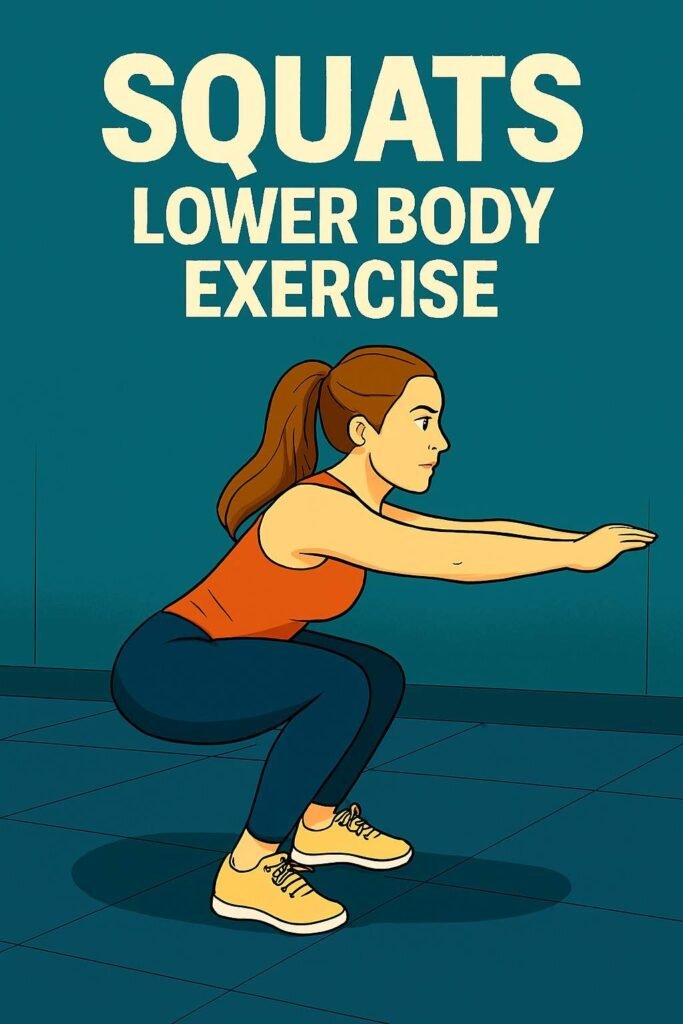
Muscles Worked: Quads, glutes, hamstrings, calves, and core.
How to Do a Proper Bodyweight Squat:
- Stand tall – Feet shoulder-width apart (or slightly wider), toes pointed slightly outward.
- Engage your core – Keep your chest up and spine neutral.
- Lower down – Push hips back as if sitting in a chair, bending knees to at least 90°.
- Drive up – Press through heels to return to standing, squeezing glutes at the top.
Common Mistakes to Avoid:
Knees caving in → Keep knees aligned with toes.
Leaning too far forward → Maintain an upright torso.
Not going low enough – Aim for thighs parallel to the floor.
Modifications:
- Easier: Hold onto a chair or wall for balance.
- Harder: Add pulses at the bottom or jump squats for intensity.
Why Squats Rock:
Boosts metabolism (big muscles = more calories burned)
Improves mobility (hips, knees, ankles)
Functional strength (helps with daily movements like sitting/standing)
Pro Tip: For better form, imagine sitting back into an invisible chair—this helps engage glutes more!
Push-Ups – The Ultimate Upper Body & Core Exercise
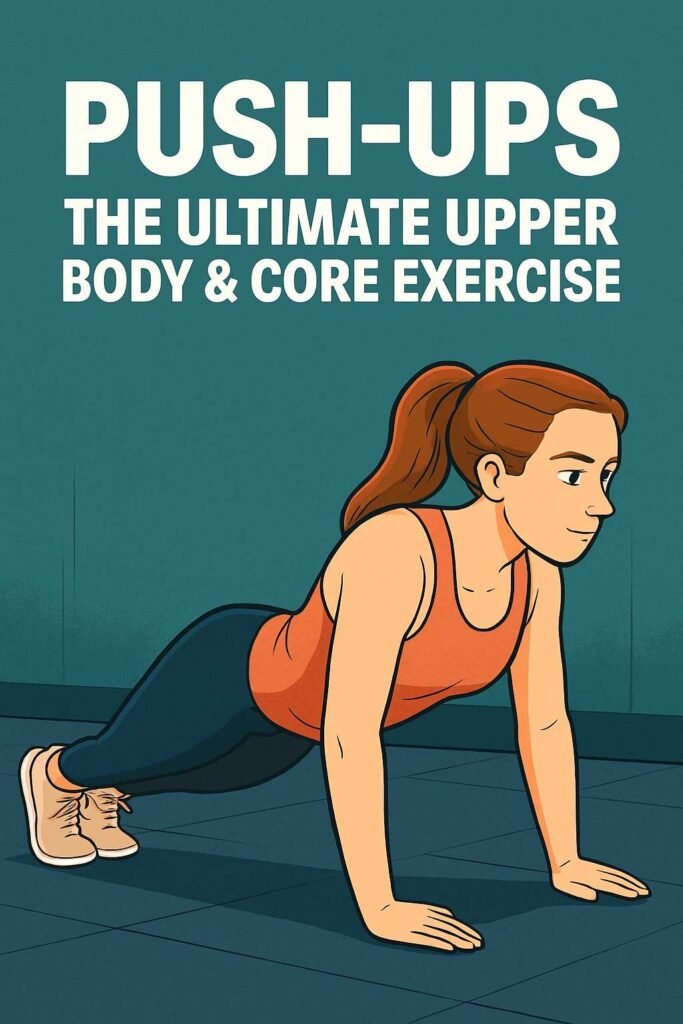
Muscles Worked: Chest (pectorals), shoulders (deltoids), triceps, and core (abs & lower back).
How to Do a Proper Push-Up:
- Start in a high plank – Hands under shoulders, body in a straight line from head to heels.
- Engage your core & glutes – Avoid sagging hips or sticking your butt up.
- Lower with control – Bend elbows to 90°, keeping them at a 45° angle from your body.
- Push back up – Exhale as you press through your palms, fully extending arms.
Common Mistakes to Avoid:
Flaring elbows out → Leads to shoulder strain (keep them at a 45° angle).
Dropping hips or arching back → Tighten core to maintain a straight line.
Partial range of motion – Go all the way down and up!
Modifications:
- Easier:
- Knee push-ups (keep core engaged!).
- Incline push-ups (hands on a bench or wall).
- Harder:
- Diamond push-ups (hands close, targets triceps).
- Plyo push-ups (explode up for power).
Why Push-Ups Rule:
Builds functional upper-body strength (essential for daily tasks).
Improves core stability (works abs better than crunches!).
No equipment needed – Do them anywhere!
Pro Tip: Squeeze your glutes to keep your body straight—this prevents lower back strain!
Reverse Lunges – Lower Body Strength & Balance Builder
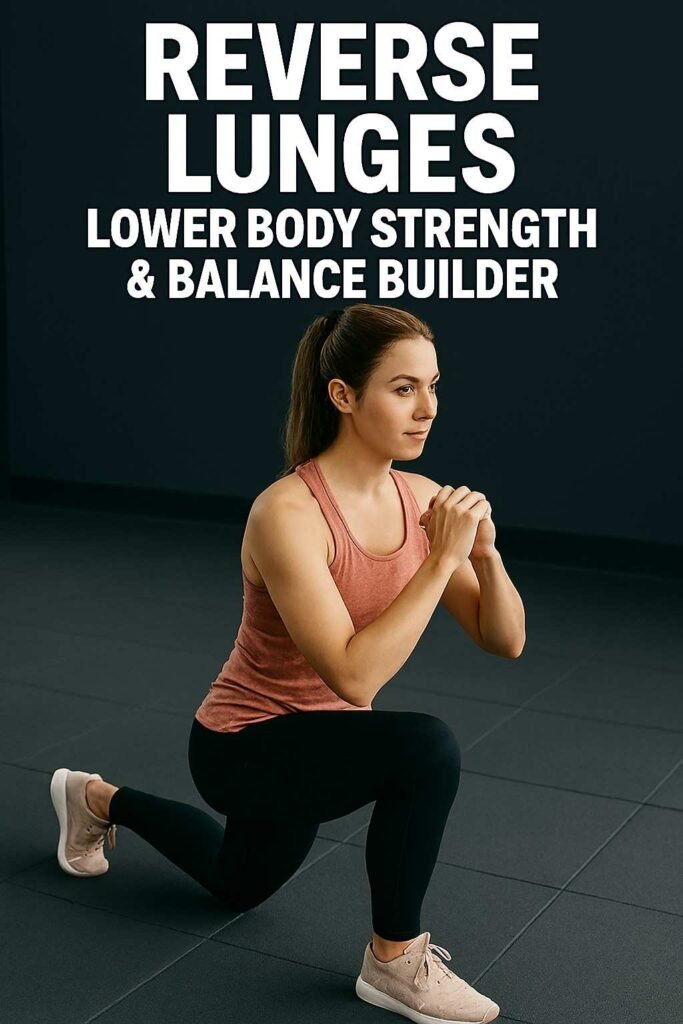
Muscles Worked: Glutes, quads, hamstrings, calves, and core (for stability).
How to Do a Proper Reverse Lunge:
- Stand tall – Feet hip-width apart, hands on hips or by your sides.
- Step back – With one leg, lower until both knees form 90° angles.
- Keep posture upright – Chest lifted, front knee aligned with ankle (not past toes).
- Push through front heel – Engage glutes to return to start.
Common Mistakes to Avoid:
Leaning forward → Keep torso vertical to protect knees.
Short-stepping → Back knee should nearly touch the floor.
Letting front knee cave in → Push it outward to align with toes.
Modifications:
- Easier:
- Hold onto a chair for balance.
- Reduce depth (only lower halfway).
- Harder:
- Add a knee drive (balance challenge!).
- Pulse at the bottom for endurance.
Why Reverse Lunges Rock:
Easier on knees than forward lunges (great for beginners!).
Improves single-leg strength (helps prevent injuries).
Boosts balance & coordination (activates stabilizing muscles).
Pro Tip: Imagine you’re lowering into a “curtsy” to engage glutes more!
Plank Shoulder Taps – Core & Shoulder Stability Challenge
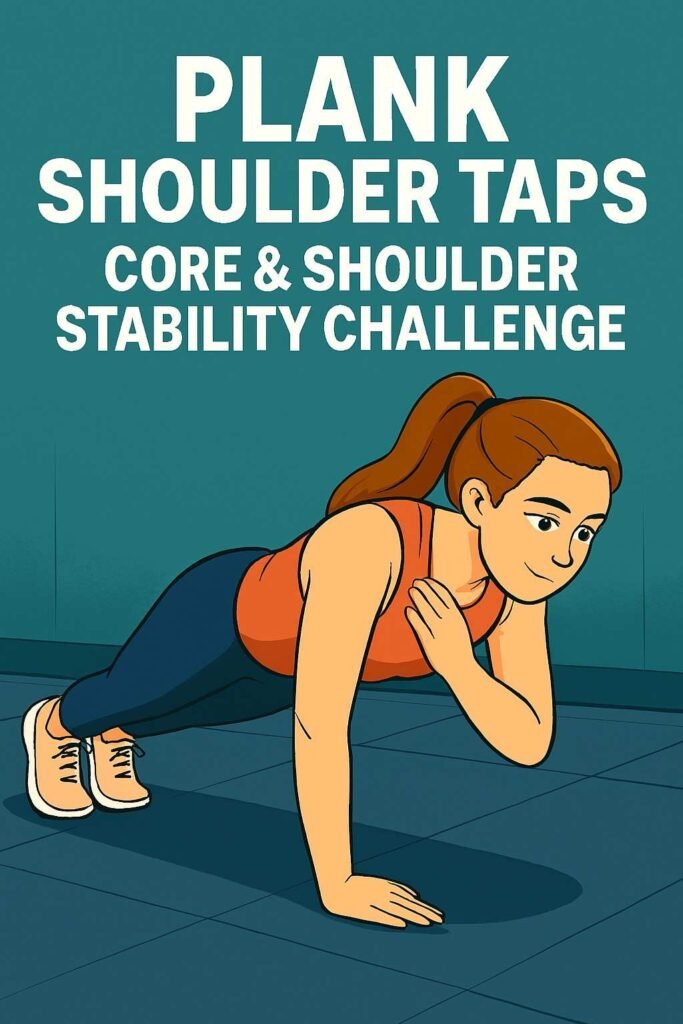
Muscles Worked: Core (rectus abdominis, obliques), shoulders (deltoids), arms, and glutes for stabilization.
How to Do It Properly:
- Start in a high plank – Hands under shoulders, body straight from head to heels.
- Engage your core – Squeeze glutes and brace abs to prevent hips from swaying.
- Tap shoulder – Lift one hand to tap opposite shoulder, keeping hips level.
- Alternate sides – Return hand to floor and repeat on the other side.
Common Mistakes to Avoid:
Hips rocking side to side → Keep core tight to minimize movement.
Rushing – Control each tap for maximum benefit.
Sagging or hiking hips – Maintain a straight back (like a tabletop!).
Modifications:
- Easier:
- Perform from knees (keep core engaged!).
- Reduce range (lightly lift fingers instead of full shoulder tap).
- Harder:
- Slow tempo (2 seconds per tap).
- Add a leg lift (opposite leg raises while tapping).
Why Plank Shoulder Taps Rule:
Builds anti-rotational core strength (key for sports and daily life).
Improves shoulder stability (prevents injuries).
Enhances balance and coordination (trains your body to resist movement).
Pro Tip: Pretend you’re balancing a glass of water on your back—minimize all movement!
Glute Bridges – The #1 Exercise for Strong, Sculpted Glutes
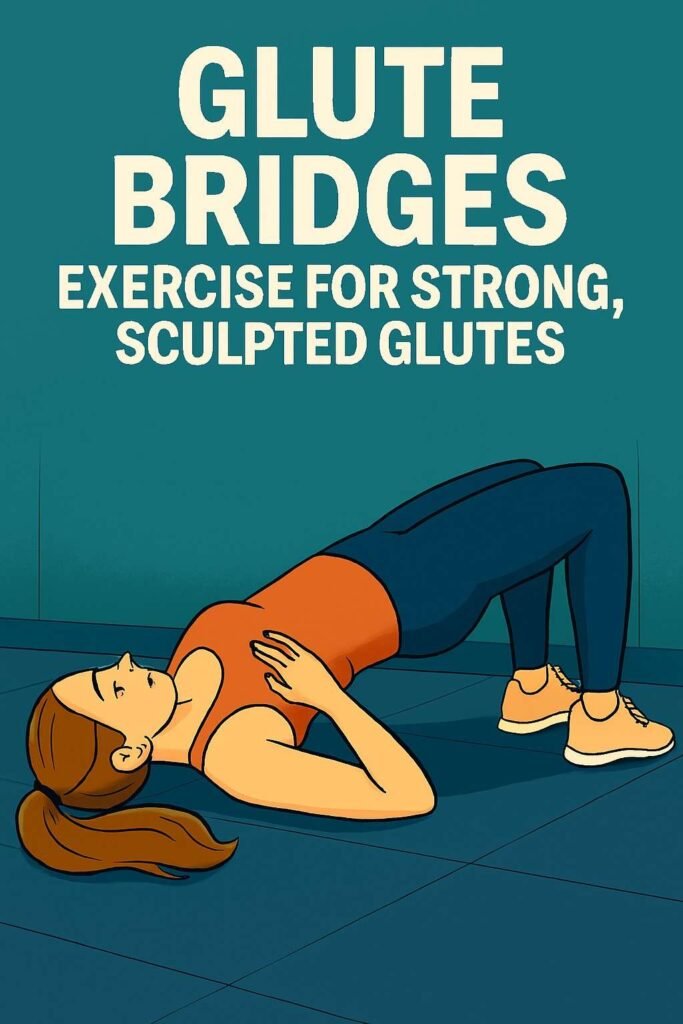
Muscles Worked: Glutes (maximus & medius), hamstrings, core, and lower back.
How to Do It Perfectly:
- Lie on your back – Knees bent, feet flat hip-width apart, arms by your sides.
- Engage your core – Gently press lower back into the floor before lifting.
- Lift your hips – Squeeze glutes to raise hips until shoulders to knees form a straight line.
- Lower with control – Slowly return to start without letting hips fully rest on the ground.
Common Mistakes to Avoid:
Overarching your back → Keep ribs down to protect your spine.
Leading with thighs instead of glutes → Focus on squeezing your butt, not pushing with quads.
Rushing the movement – Slow and controlled = better activation!
Level Up or Down:
- Easier:
- Reduce range (lift halfway).
- Place hands under hips for support.
- Harder:
- Single-leg glute bridge (one foot lifted).
- Add a 3-second hold at the top.
- Place feet on an elevated surface (like a couch).
Why Glute Bridges Are Essential:
Fixes “dead butt syndrome” (from too much sitting!).
Improves posture and hip mobility.
Prevents lower back pain by strengthening the posterior chain.
Pro Tip: Place a resistance band above your knees and press outward to fire up glute medius!
Mountain Climbers – The Ultimate Cardio + Core Blaster

Muscles Worked: Core (abs + obliques), shoulders, chest, hip flexors, and legs.
How to Do It Right:
- Start in a high plank – Hands under shoulders, body straight (no sagging hips!).
- Drive knees toward chest – Alternate legs quickly while keeping hips stable.
- Stay light on your feet – Imagine running in place horizontally.
- Control your breathing – Exhale as each knee comes forward.
Common Mistakes to Avoid:
Hips bouncing up/down → Keep them level (pretend you’re balancing a book!).
Shallow knee drives – Bring knees as far forward as possible.
Holding your breath – Steady inhales/exhales prevent burnout.
Make It Easier or Harder:
- Easier:
- Slow it down (1-2 second holds per knee).
- Step feet in/out instead of running motion.
- Harder:
- Add a push-up every 5 reps.
- Place hands on a unstable surface (like a towel on hardwood).
- Try cross-body climbers (knee to opposite elbow).
Why Mountain Climbers Dominate:
Torches calories fast (full-body cardio + strength combo).
Boosts agility and coordination.
No space needed – Perfect for small home workouts.
Pro Tip: The slower you go, the more core you engage – try 3 seconds per knee for a brutal burn!
Cool-Down & Stretching (5 Minutes) – Recover Like a Pro
After crushing your 30-minute no-equipment full-body workout, a proper cool-down is essential to:
✔ Lower your heart rate gradually
✔ Reduce muscle stiffness and soreness
✔ Improve flexibility and relaxation
Static stretching (holding stretches for 15-30 seconds) helps release tension and increase blood flow to tired muscles.
5-Minute Cool-Down Routine
1️⃣ Hamstring Stretch (Targets: Back of thighs)
- Sit on the floor, extend one leg straight, and reach toward your toes.
- Keep your back flat—hinge at the hips, not your spine!
- Hold 15-30 sec per leg.
2️⃣ Chest Opener (Targets: Chest & shoulders)
- Clasp hands behind your back, straighten arms, and lift slightly.
- Open your chest and take deep breaths.
- Hold 20-30 sec.
3️⃣ Child’s Pose (Targets: Back, hips, and shoulders)
- Kneel on the floor, sit back onto your heels, and stretch arms forward.
- Relax your forehead to the ground and breathe deeply.
- Hold 30 sec.
4️⃣ Seated Spinal Twist (Targets: Spine & obliques)
- Sit with legs extended, bend one knee over the other, and twist toward the bent knee.
- Use your opposite arm for a deeper stretch.
- Hold 20 sec per side.
5️⃣ Butterfly Stretch (Targets: Inner thighs & hips)
- Sit with soles of feet together, knees dropped to sides.
- Gently press knees down with elbows while keeping your back straight.
- Hold 20-30 sec.
Pro Tips for Recovery:
Hydrate well – Drink water to replenish lost fluids.
Rest & refuel – Eat protein + carbs within 30-60 mins post-workout.
Foam roll later – Helps further release tight muscles.
Great job! Your body will thank you tomorrow.
Nutrition Tips to Maximize Your 30-Minute No-Equipment Workout Results

Fueling your body properly is just as important as the workout itself! Follow these simple nutrition tips to boost energy, enhance recovery, and get the most out of your full-body home workouts.
1️⃣ Hydrate, Hydrate, Hydrate!
- Before workout: Drink 1-2 glasses of water 30 mins before exercising.
- During workout: Sip water to stay hydrated (especially if sweating).
- After workout: Replenish with electrolytes (coconut water or a pinch of salt in water) if needed.
Why? Dehydration = fatigue, cramps, and poor performance!
2️⃣ Pre-Workout Fuel (30-60 Mins Before)
- Light & energizing: Banana, oatmeal, or a small smoothie.
- Avoid heavy meals (digestion takes energy away from your workout).
Best options:
✔ Banana + almond butter (quick carbs + healthy fats)
✔ Greek yogurt + berries (protein + antioxidants)
3️⃣ Post-Workout Recovery (Within 60 Mins)
- Protein + carbs combo to repair muscles and replenish energy.
Best options:
✔ Scrambled eggs + whole-grain toast
✔ Grilled chicken + sweet potato
✔ Protein smoothie (whey protein, spinach, banana, almond milk)
Why? Protein rebuilds muscle, and carbs restore glycogen!
4️⃣ Daily Eating Habits for Better Results
- Prioritize protein (chicken, fish, tofu, lentils) to maintain muscle.
- Eat fiber-rich carbs (quinoa, oats, veggies) for sustained energy.
- Healthy fats (avocado, nuts, olive oil) for hormone balance.
Avoid:
Sugary snacks (energy crash!)
Processed foods (inflammation = slower recovery)
5️⃣ Listen to Your Body!
- Hungry? Eat a balanced snack (e.g., nuts + fruit).
- Sore muscles? Tart cherry juice or turmeric can help with inflammation.
Pro Tip: Meal prep easy, high-protein snacks (hard-boiled eggs, Greek yogurt) to stay on track!
Final Thought:
You don’t need a strict diet—just consistent, balanced eating to support your 30-minute no-equipment workouts and see real progress!
Eat well, train smart, and recover stronger!
Conclusion
In conclusion, the 30-Minute No-Equipment Full Body Workout is a simple yet highly effective way for beginners to kickstart their fitness journey without the need for a gym or expensive equipment. This challenge proves that you don’t need complicated routines to see results—just dedication, consistency, and the right exercises. By targeting all major muscle groups and combining strength with cardio, this workout boosts endurance, builds muscle tone, and improves overall health in a short amount of time.
The beauty of this approach lies in its flexibility. You can do it at home, in a park, or even in a hotel room while traveling. Plus, it’s beginner-friendly, meaning you can start at your own pace and gradually increase intensity as your strength and stamina improve. Whether your goal is weight loss, muscle definition, or simply feeling more energized, committing to this daily or weekly routine can deliver visible progress in just a few weeks.
So, roll out a mat, put on some comfortable clothes, and embrace the 30-Minute No-Equipment Full Body Workout challenge. Remember, the hardest step is starting—once you make it a habit, your body and mind will thank you. Fitness doesn’t have to be complicated; sometimes, all it takes is 30 minutes a day to transform your health and confidence.
